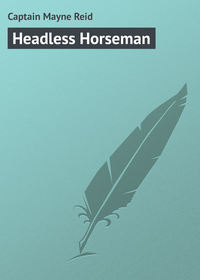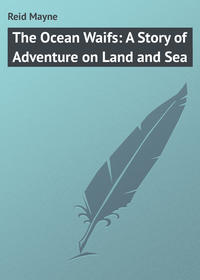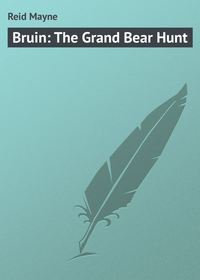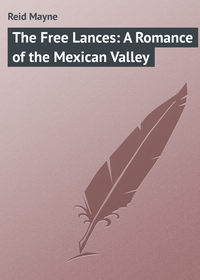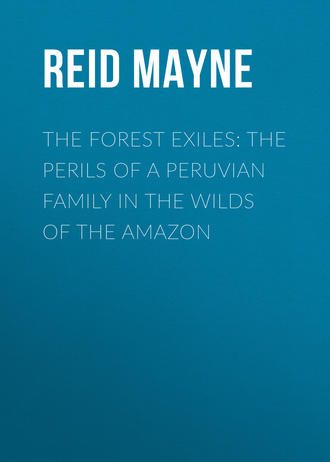 полная версия
полная версияThe Forest Exiles: The Perils of a Peruvian Family in the Wilds of the Amazon
First, a round ring of large stones had been laid, then a row of turf, then another tier of stones, and so on, until the circular wall had reached the height of about four or five feet, the diameter being not more than eight or nine. On the top of the wall a number of poles had been set, so as to meet above where they were tied together. These poles were nothing else than the long flower-stalks of the maguey or American aloe (Agave Americana), as no other wood of sufficient length grew in the vicinity. These poles served for rafters, and across them laths had been laid, and made fast. Over all this was placed a thatch of the long coarse Puna grass, which was tied in its place by grass ropes that were stretched from side to side over the top. This was the hut of Guapo’s friend, and similar to all others that may be encountered in the wild region of the Puna. A door was left in the side, not over two feet high, so that it was necessary to crawl upon the hands and knees before any one could reach the interior.
As our travellers approached, they saw that the entrance was closed by an ox-hide which covered the whole of the opening.
Whether the shepherd was at home, was the next question; but as they got near to the house, Guapo suggested that Don Pablo should dismount and let Leon get upon horseback. This suggestion was made on account of the Puna dogs – of which creatures Guapo had a previous knowledge. These dogs, known by the name of Inca dogs (Canis Ingae), are, perhaps, the fiercest animals of their species. They are small, with pointed muzzles, tails curling upward, and long shaggy hair. They are half-wild, snappish, and surly, as it is possible for dogs to be. They attack strangers with fury, and it is as much as their masters can do to rescue even a friend from their attack. Even when wounded, and unable any longer to keep their feet, they will crawl along the ground and bite the legs of those who have wounded them. They are even more hostile to white people than to Indians, and it is sometimes dangerous to approach an Indian hut where three or four of these fierce creatures are kept, as they will jump up against the side of a horse, and bite the legs of the rider. Their masters often use the stick before they can get obedience from them. In every Indian hut several of these animals may be found, as they are extremely useful to the shepherds in guarding their flocks and for hunting. They are much employed throughout the Puna to hunt the “yutu,” a species of partridge which inhabits the rushy grass. This bird is traced by the dogs, seized before it can take to flight, and killed by a single bite of its fierce pursuer. Considering the savage nature of the Inca dogs, Guapo showed great caution in approaching the hut of his friend. He first called loudly, but there was no reply. He then stole forward with his long knife, or “macheté” in his hand; and having lifted the skin that covered the low doorway, peeped in. The hut was empty.
Chapter Six.
The wild Bull of the Puna
Guapo was not much troubled at this. He knew he could take the liberty of using his friend’s roof for the night, even should the latter not return to grant it. He crawled in. Of course his friend was only temporarily absent – no doubt looking after his flocks of sheep and alpacos; and as he was a bachelor, there was no wife at home, but there were his furniture and utensils. Furniture! No – there was none. There never is in the hut of a Puna shepherd. Utensils! yes – there was an earthen “olla,” or pot to cook soup in, another to boil or roast maize, a jar to hold water, a few split gourd-shells for plates, two or three others for cups – that was all. This was the catalogue of utensils. Two stones set a little apart formed the fire-place, in which the shepherd, when he makes a fire to cook with, makes it out of dry dung (taquia). A couple of dirty sheepskins lay upon the ground. These were the bed. Nothing more was to be seen. Yes, there was one thing more, and this gladdened the eyes of Guapo. In a bag that hung against the wall, and on which he soon laid his hands, he felt something – a collection of hard round objects, about as big as large chestnuts. Guapo knew very well what these were. He knew they were “macas.”
What are macas? you will ask. Macas, then, are tuberous roots that grow in the elevated regions of the Puna, where neither ocas, ullucas, nor potatoes, will thrive. They are cultivated by the inhabitants, and in many parts constitute almost the only food of these wretched people. They have an agreeable and rather sweetish flavour, and, when boiled in milk, taste somewhat like boiled chestnuts. They can be preserved for more than a year, by simply drying them in the sun, and then exposing them to the cold air, when they become hard and shrivelled. They thrive best in this high region, for although they will grow in the lower valleys, they are there very insipid and worthless. The Indians prepare them for food by boiling them into a soup, or syrup, which is taken with parched maize-corn.
Guapo knew that he had got his hands upon a bag of dried macas, and although their owner was absent, he had already come to the determination to appropriate them for himself and party. His joy at the discovery had not subsided when another bag drew his attention, and this was the signal for another delightful surprise. His hand touched the new bag in a trice. There was a rattling sound within. Peas? No – maize.
“Good!” ejaculated Guapo; “maize and macas! That with what is left of the charqui – we shall not fast to-night.”
Guapo now backed himself out of the hut, and joyfully announced the discoveries he had made. The travellers dismounted. The horse and mule were picketed on lassoes on the plain. The llamas were left to go at will. They would not stray far from their owner.
It was piercing cold in this highland region. Doña Isidora and the children entered the hut, while Don Pablo and Guapo remained without for the purpose of collecting fuel. There was not a stick of wood, as no trees of any sort grew near. Both strayed off upon the plain to gather the taquia, or ordure of the cattle, though no cattle were in sight. Their tracks, however, were visible all around.
While engaged thus, the old Indian suddenly raised himself from his stooping position with an exclamation that betokened alarm. What had startled him? A loud bellowing was heard – it was the bellowing of a bull. But what was there in that sound to alarm two full-grown men? Ah! you know not the bulls of the Puna.
Coming around a promontory of rocks a large black bull was in sight. He was approaching them in full run, his head thrown down, his eyes glaring fiercely. At every spring he uttered a roar, which was terrific to hear. A more horrid object it would be difficult to conceive. You may suppose that an adventure with an enraged bull is one of an ordinary character, and may occur any day, even in the green meadow pastures of Old England. So it is, if the animal were only an English bull. But it is a far different affair with the bulls of the Puna. Throughout all Spanish America animals of this kind are of a fiercer nature than elsewhere. It is from them the bulls used in the celebrated fights are obtained; and, perhaps, the race has been made fiercer by the treatment they receive on such occasions – for many of those that exhibit in the arena, are afterwards used to breed from. But, in general, the Spanish-American “vaqueros,” or cattle – herds, treat the cattle under their charge with much cruelty, and this has the effect of rendering them savage. Even in herds of cattle where there are no bulls, there are cows so dangerous to approach, that the vaqueros never attempt driving them unless when well mounted. A Mexican or South American cattle-herd is, therefore, always a mounted man. There is a difference, too, among the bulls in different parts of these countries. On the Llanos of Venezuela they are not so fierce as those of the Puna, and they are more and less so in different parts of Mexico and the Pampas of Buenos Ayres.
The Puna bulls are, perhaps, the fiercest and most dangerous of all. They are more than half wild. They scarcely ever see a human being, and they will attack one upon sight. To a mounted man there is little danger, unless by the stumbling or falling of his horse; but many a poor Indian, crossing these high plains afoot, has fallen a sacrifice to these vengeful brutes.
Both Don Pablo and Guapo knew all this, and therefore were aware of their own danger. Neither had a weapon – not so much as a stick. They had laid aside their knives and other arms, which had been carried inside the hut. To reach the hut before the bull reached them would be impossible; the brute was coming nearly from it – for he had issued from some shelter in the rocks not far off. They were full two hundred yards out upon the plain, and to run in the direction of the rocks would have been to run counter to the bull, and meet him face to face! Their danger was imminent. What was to be done?
There was not much time left them for consideration. The furious animal was within thirty paces distance, roaring loudly, shaking his head and brandishing his long sharp horns. At this moment a happy thought occurred almost simultaneously to Don Pablo and the Indian. The evening, as we have already said, was piercing cold, and both, in going out to collect the fuel, had worn their ponchos. The trick of the matador with his red cloak suggested itself in this moment of peril. Both had seen it performed – Don Pablo often – and knew something of the “way.” In a moment both had stripped the ponchos from their shoulders, and, placing themselves a la matador, awaited the onset of the bull. It was agreed that as soon as the bull was “hooded” by either, that both should run at all speed to the rocks, where they could easily climb out of reach of the animal.
Don Pablo happened to be more in the way, and perhaps his more showy poncho attracted the brute; but whether or not, he was the first to receive the charge. With the adroitness of a practised matador he flung his poncho on the horns of the animal, and then both ran in the direction of the rocks. As they faced towards the hut, however, to the horror of Don Pablo he saw the Doña Isidora, with Leon and the little Leona, all outside, and even at some distance from the entrance! Attracted by the bellowing of the bull and the shouts of the men, they had rushed out of the hut.
Don Pablo, in wild accents, shouted to them to make for the door; but, paralysed by terror, they were for some moments unable to move. At length Doña Isidora, recovering herself, ran for the entrance, pushing the children before her. But the low doorway was difficult of access; they were slow in getting under it; and they would have been too late, as the bull, after shaking off the poncho, had turned and made directly for the hut.
“O God, preserve her!” cried Don Pablo, as he saw the enraged animal within a few paces of where his wife had knelt to enter the doorway. “She is lost! she is lost!”
In fact, the bull was making directly towards her, and it seemed as if nothing could then have interposed to save her.
At that moment the tramp of a horse in full gallop sounded on their ears. Don Pablo looked up. A strange horseman was near the spot – an Indian. Over his head a singular instrument was revolving. There were three thongs fastened at one end, while at the other end of each was a ball. These balls were whirling and gyrating in the air. The next moment both thongs and balls were seen to part from the hands of the rider, and warp themselves around the legs of the bull. The latter made an awkward spring forward, and then fell upon the plain, where he lay kicking and helpless. The horseman uttered a yell of triumph, sprang from his horse, and running up to the prostrate animal, thrust the blade of his long macheté into its throat. The red stream gushed forth, and in a few seconds the black monster lay motionless upon the plain.
The new-comer quietly unwound the thongs – the bolas– from the legs of the dead bull, and then addressed himself to our travellers.
Chapter Seven.
The “Vaquero.”
Who was this deliverer? No other than the vaquero – the friend of Guapo, – who now welcomed Guapo and his companions, telling them in the polite phraseology of all Spanish-Americans that his house (?) was at their service. They were welcome to all it contained.
The macas, and maize, and a fresh steak from the wild bull, enabled them to make a most excellent supper. In return for this hospitality, Don Pablo made the vaquero a handsome present out of his purse; but what gratified him still more was a supply of coca which his friend Guapo was enabled to bestow upon him, for his own stock had been exhausted for some days. Guapo, on leaving Cuzco, had spent his last peseta in buying this luxury, and therefore was well provided for weeks to come.
After they had had supper, he and his friend seated themselves on one side, and quietly chewed for a good half-hour, when at length Guapo, who knew he could trust the vaquero – because the latter, like himself, was one of the “patriotas” – communicated to him the object of their journey through that desolate region. The vaquero not only promised secrecy, but bound himself to put any party of pursuers completely off the trail. The vaquero, even in his remote mountain-home, had heard of Don Pablo, knew that he was a good patriot and friend of the Indians, and he would therefore have risked his life to serve such a man – for no people have proved more devoted to the friends of their race than these simple and faithful Indians of the Andes. How many instances of noble self-sacrifice – even of life itself – occurred during the painful history of their conquest by the cruel and sanguinary followers of Pizarro!
The vaquero, therefore, did all in his power to make his guests comfortable for the night. His dogs – there were four of them – were not so hospitably inclined, for they did not seem to know friends from enemies. They had come up shortly after their master himself arrived, and had made a desperate attack upon everybody. The vaquero, however, assisted by Guapo – who, being an Indian, was less troubled with them – gave them a very rough handling with a large whip which he carried; and then, securing the whole of them, tied them together in a bunch, and left them at the back of the hut to snap and growl at each other, which they did throughout the live-long night. Supper over, all the travellers would have retired to rest; but the vaquero, having announced that he was going out to set snares for the chinchillas and viscachas, Leon could not rest, but asked permission to accompany him. This was granted both by Don Pablo and the vaquero himself.
The chinchilla, and its near relative the viscacha, are two little animals of the rodent, or grass-eating kind, that inhabit the very highest mountains of Peru and Chili. They are nearly of the same size, and each about as big as a rabbit, which in habits they very much resemble. They have long tails, however, which the rabbit has not, though the latter beats them in the length of his ears. The colour of the chinchilla is known to everybody, since its soft, velvety fur is highly prized by ladies as an article of dress, and may be seen in every London fur-shop. The animal is of a beautiful marbled grey, white and black, with pure white feet. The fur of the viscacha is not so pretty, being of a brownish and white mixture. Its cheeks are black, with long, bristly moustaches, like those of a cat while its head resembles that of the hare or rabbit. Both these innocent little creatures live upon the high declivities of the Andes, in holes and crevices among the rocks, where they remain concealed during the day, but steal out to feed twice in the twenty-four hours, – that is, during the evening twilight and in the early morning. The mode of capturing them is by snares made of horse-hair, which are set in front of their caves – just as we snare rabbits in a warren, except that for the rabbits we make use of light elastic wire, instead of the horse-hair.
Leon was delighted with the excursion, as the vaquero showed him how to set the snares, and told him a great many curious stories of Puna life and habits. Some of these stories were about the great condor vulture – which the narrator, of course, described as a much bigger bird than it really is, for the condor, after all, is not so much bigger than the griffon vulture, or even the vulture of California. But you, young reader, have already had a full account of the vultures of America – the condor among the rest – therefore we shall not repeat what was said by the vaquero about this interesting bird.
On the way to the place where the snares were to be set, they passed a lagoon, or marshy lake, in which were many kinds of birds peculiar to these high regions. Out on the open water they saw a wild goose of a very beautiful species. It is called the “Huachua” goose. Its plumage is of a snowy whiteness, all except the wings, which are bright green and violet, while the beak, legs, and feet, are scarlet. They also saw two species of ibis wading about in the marsh, and a gigantic water-hen (Fulica gigantea) almost as big as a turkey. This last is of a dark grey colour, with a red beak, at the base of which is a large yellow knob of the shape of a bean. On this account it is called by the Indians “bean nose.” Upon the plain, near the border of the marsh, they noticed a beautiful plover (Charadrius), having plumage marked very much like that of the “huachua” goose, with green wings shining in the sun like polished metal. Another curious bird also sat upon the plain, or flew around their heads. This was a bird of prey of the species of jerfalcons (Polyborus). The vaquero called it the “Huarahua.” He told Leon it preyed only on carrion, and never killed its own food; that it was very harmless and tame – which was evidently true, as, shortly after, one of them seated upon a stone allowed the Indian to approach and knock it over with a stick! Such a silly bird Leon had never seen.
The vaquero was quite a naturalist in his way – that is, he knew all the animals of the Puna, and their habits, just as you will sometimes find a gamekeeper in our own country, or often a shepherd or farm-servant. He pointed out a rock-woodpecker, which he called a “pito” (Colaptes rupicola), that was fluttering about and flying from rock to rock. Like the cliff-parrots we have already mentioned, this rock-woodpecker was a curious phenomenon, for, as their very name implies, the woodpeckers are all tree-dwelling birds, yet here was one of the genus living among rocks where not a tree was to be seen, and scarcely a plant, except the thorny cactuses and magueys, with which succulent vegetables the woodpecker has nothing to do. The “pito” is a small, brown, speckled bird, with yellow belly, and there were great numbers of them flying about.
But the bird which most fixed the attention of Leon was a little bird about the size of a starling. Its plumage was rather pretty. It was brown, with black stripes on the back, and white-breasted. But it was not the plumage of the bird that interested Leon. It was what his companion told him of a singular habit which it had – that of repeating, at the end of every hour during the night, its melancholy and monotonous note. The Indians call this bird the “cock of the Inca,” and they moreover regard it with a sort of superstitious reverence.
Having placed his snares, the vaquero set out to return with his youthful companion. As they walked back along the mountain-foot, a fox stole out from the rocks and skulked towards the marshy lake, no doubt in search of prey. This fox was the Canis Azara, a most troublesome species, found all through South America. He is the great pest of the Puna shepherds, as he is a fierce hunter, and kills many of the young lambs and alpacos. The vaquero was sorry he had not his dogs with him, as, from the route the fox had taken, he would have been certain to have captured him, and that would have been worth something, for the great sheep-owners give their shepherds a sheep for every old fox that they can kill, and for every young one a lamb. But the dogs, on this occasion, had been left behind, lest they should have bitten Leon, and the vaquero was compelled to let “Renard” go his way. It was night when they returned to the hut, and then, after Leon had related the details of their excursion, all retired to rest.
Chapter Eight.
Llamas, Alpacos, Vicuñas, And Guanacos
Our travellers were stirring by early break of day. As they issued from the hut, a singular and interesting scene presented itself to their eyes. At one view – one coup d’oeil– they beheld the whole four species of the celebrated camel-sheep of the Andes; for there are four of them, – llama, guanaco, alpaco, and vicuña! This was a rare sight, indeed. They were all browsing upon the open plain: first, the llamas, near the hut; then a flock of tame alpacos, out upon the plain; thirdly, a herd of seven guanacos farther off; and still more distant, a larger herd of the shy vicuñas. The guanacos and vicuñas were of uniform colours, – that is, in each flock the colour of the individuals was the same; while among the llamas and alpacos there were many varieties of colour. The latter two kinds were tame, – in fact, they were under the charge of Guapo’s friend the shepherd; whereas the herds of vicuñas and guanacos consisted of wild animals.
Perhaps no animal of South America has attracted so much attention as the llama, as it was the only beast of burden the Indians had trained to their use on the arrival of Europeans in that country. So many strange stories were told by the earlier Spanish travellers regarding this “camel-sheep,” that it was natural that great interest should attach to it. These reported that the llama was used for riding. Such, however, is not the case. It is only trained to carry burdens; although an Indian boy may be sometimes seen on the back of a llama for mischief, or when crossing a stream and the lad does not wish to get his feet wet.
The llama is three feet high from hoof to shoulder, though his long neck makes him look taller. His colour is generally brown, with black and yellow shades, sometimes speckled or spotted; and there are black and white llamas, but these are rare. His wool is long and coarse, though the females, which are smaller, have a finer and better wool. The latter are never used to carry burdens, but only kept for breeding. They are fed in flocks upon the Puna heights, and it was a flock of these that our travellers saw near the hut.
The males are trained to carry burdens at the age of four years. A pack-saddle, called yergua, woven out of coarse wool, is fastened on the back, and upon this the goods are placed. The burden never exceeds 120 or 130 pounds. Should a heavier one be put on, the llama, like the camel, quite understands that he is “over-weighted,” and neither coaxing nor beating will induce him to move a step. He will lie down, or, if much vexed, spit angrily at his driver, and this spittle has a highly acrid property, and will cause blisters on the skin where it touches. Sometimes a llama, over vexed by ill-treatment, has been known, in despair, to dash his brains out against a rock.
The llamas are used much in the mines of Peru, for carrying the ore. They frequently serve better than either asses or mules, as they can pass up and down declivities where neither ass nor mule can travel. They are sometimes taken in long trains from the mountains down to the coast region for salt and other goods; but on such occasions many of them die, as they cannot bear the warm climate of the lowlands. Their proper and native place is on the higher plains of the Andes.
A string of llamas, when on a journey, is a very interesting spectacle. One of the largest is usually the leader. The rest follow in single file, at a slow, measured pace, their heads ornamented tastefully with ribands, while small bells, hanging around their necks, tinkle as they go. They throw their high heads from side to side, gazing around them, and when frightened at anything, will “break ranks,” and scamper out of their path, to be collected again with some trouble. When resting, they utter a low, humming noise, which has been compared to the sound of an Eolian harp. They crouch down on their breast – where there is a callosity – when about to receive their burdens, and also sleep resting in the same attitude. A halt during the day is necessary, in order that they may be fed, as these animals will not eat by night. In consequence of this they make but short journeys – ten to fifteen miles – although they will travel for a long time, allowing them a day’s rest out of every five or six. Like the camels of the East, they can go days without water, and Buffon knew one that went eighteen months without it! but Buffon is very poor authority. When one of them becomes wearied, and does not wish to proceed, it is exceedingly difficult to coax him onward.




